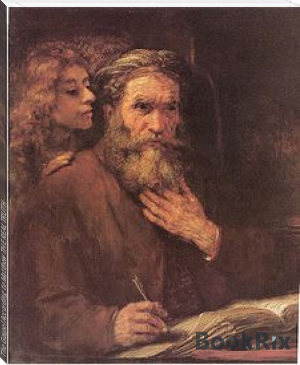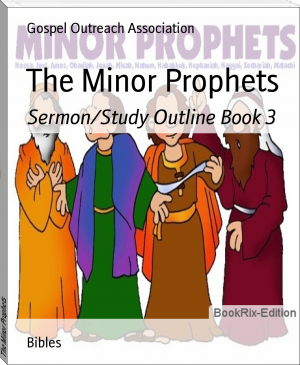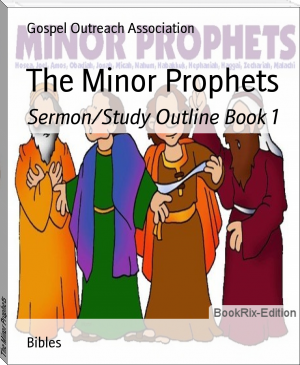Book of Revelation HIDEN TRUTH, JACOB GEORGE [free ebook reader for pc txt] 📗

- Author: JACOB GEORGE
Book online «Book of Revelation HIDEN TRUTH, JACOB GEORGE [free ebook reader for pc txt] 📗». Author JACOB GEORGE
The Book of Revelation by John
Our Web : http://fm-church.blogspot.com
For Copies Please contact :
G Jacob George, S/O Rev G Dayanand
# 1-9-69/A/1, Ramnagar, Hyderabad,
Telangana(AP), India – 500020.
Mobile # 91-09985117937 , 91-09177389232
E Mail ID – gjacobgeorge77@gmail.com, gjacobgeorge@rediffmail.com.
Index
S.No Name Page No
Introduction 3-6
Meaning 7
Historical background 8-12
Theme 13-15
Focus (Subject expanding) 16-33
Application to present day context 34-38
Reflection 39-50
Introduction
The Book of Revelation was written sometime around 96 CE in Asia Minor. The author was probably a Christian from Ephesus known as "John the Elder." According to the Book, this John was on the island of Patmos, not far from the coast of Asia Minor, "because of the word of God and the testimony of Jesus" (Rev. 1.10). This has traditionally been taken to mean that he had been exiled there as a martyr for his Christian faith. Some scholars, however, have suggested that it might have been a regular stop on a preaching circuit. Next, the author says, "I was in the spirit on the Lord's day, and I heard behind me a loud voice like a trumpet" (Rev. 1.11), and this voice tells him to write what he is about to see. This begins the "revelatory" vision that is at the center of the book.
Ephesus was both the capital of the Roman province of Asia and one of the earliest centers of Christianity. The book next contains seven short letters of exhortation to the Christian churches in the seven leading cities of Asia Minor -- Ephesus (2.1-7, Smyrna (2.9-11), Pergamon (2.12-17) , Thyatira (2.18-29). Sardis (3.1-6), Philadelphia (3.7-13). and Laodicea (3.14-22). This region would become a key area for the expansion of Christianity into the Roman Empire. But it was precisely this intersection that created the problem for the author, as it called for Christians to treat the Roman administration as agent of the devil. But recognizing this comes from understanding how to read this kind of apocalyptic literature.
The Book of Revelation in the New Testament has the literal title in Greek, the "Apocalypse of John." The word apocalypse means revelation. That which is uncovered. It comes from the Greek word which literally means to pull the lid off something. So that which is revealed is central to the way that apocalyptic literature works. ... The word "apocalypse" refers to a genre of literature like the Book of Revelation itself. They are pieces of literature that start by revealing something or seeing visions or having individuals be taken up into heaven where they can see what's going on from that vantage point.
Introduction
Because of intricate and unusual symbolic language, the Book of Revelation is hard for modern people to read. They are not used to this kind of literature. Not so for people in the ancient world who would have been more accustomed to the complex nature of apocalyptic literature. The very fact that an apocalypse was a common type of literature meant that if followed certain conventions of style, and people knew more what to expect from it. Because there were many other examples of apocalyptic writing, these conventions would have seemed less strange and cryptic. Also, apocalyptic literature was almost always a kind of literature for "insiders," that is to say, it was written for people who already knew something of the situation
and of the symbols that were used to portray it. So, for the original audience of the Revelation of John, all these strange scenes would have been immediately intelligible. What the modern reader or biblical scholar has to do is to try to read the text with "ancient eyes," by being informed about the way the literature worked and the situation out of which it came.
So let's look briefly at the layout of Revelation. The book breaks naturally into five major visions plus a prologue and an epilogue on how these came to be written down. This yields our basic outline of the work, as follows:
The Prologue (1.1-3)
John's "Cover Letter" (1.4-20) and The First Vision
The Letters to the Seven Churches of Asia (2.1-3.22)
The Second Vision: In the Throne Room of Heaven (4.1-11.19)
The Seven Seals and the Seven Trumpets
[Third Vision] Three Great Signs In Heaven: The Cosmic War (12.1-16.21)
The Beasts, the war, seven plagues, seven bowls of wrath, and Battle of Armageddon
The Fourth Vision: The Judgment on Babylon [=Rome] (17.1-21.8)
Part I: The Allegory of the Great Whore - (17.1-18)
Part II: Babylon [Rome] is Fallen! (18.1-8)
Part III: Heaven is once again opened: the 1,000 years (19.11-21.8)
Part IV: A New Heaven and New Earth (21.1-8)
The Fifth Vision: The New Jerusalem (21.9-22.5)
The Epilogue: (22.6-21)
Introduction
Then in each of these visions, there is a literary device that provides for each new thing seen to propel the viewer on to the next vision. We can see this from the beginning of Vision 1, where John sees the seven lampstands, and then is told to write letters to the seven churches of Asia, for which they stand. But we see it even more clearly in the Vision II in the section that begins by seeing the scroll with seven seals, and then each of the seals is opened one at a time. But the opening of each seal does not result in the same amount of text: the first four are very brief, only two verses each. Then the fifth is longer, and the sixth is the most important, the climax of the sequence, followed by a longer vision. Finally, comes the seventh seal, but when we get there it turns out to be the seven trumpets, and the whole process starts over again as each of the trumpets is sounded in order.
What results from this is a kind of composite picture created by the cumulative effect of all the material laid out this way. It's been likened to "chinese boxes" where one opens up a box only to discover another box inside. In the final analysis one gets the sense that we (that is, the ancient "reader") are always in the sixth, just on the verge of the seventh thing happening. That's what gives the book its sense of urgency and feel that something important is just about to happen. The overall impact of Vision II, then, is to show the dire and precarious position in which the faithful are now standing, as they await the final things to take place. It is described as a time of famine, plague, oppression, and woe. But all of this probably comes out of retrospection on the First Revolt and the devastation that occurred when Jerusalem and the Temple were destroyed. That is precisely the reflection that one sees in the description of the "two witnesses" (or martyrs) who are said to have been slain in the very city where Jesus was killed (11.1-13). So, the sense of desperation and suffering that is so central to Vision II is a direct commentary on the outcome of the War of 66-70 CE.
At the end of Vision II, when the seventh angel finally sounds his trumpet (11.15-19), then the heavenly throne room of God is once again opened, and now there appears a new scene. This is the opening of Vision III, the three Signs (or Portents) in Heaven, which are the centerpiece, both literarily and ideologically, of the entire work. For these three "signs" provide the explanation for why the woes and suffering described in Vision II have come upon the earth. The answer, we are now told, is that the war on earth is merely a continuation of a cosmic war begun in heaven between God and Satan (12.1-17).
Introduction
At the end Satan, the Great Red Dragon, is thrown down to earth with his evil angels, and now they begin to make war on the saints (12.18). For his henchmen, the Dragon chooses two helpers, who are called "the beast from the sea" (13.1-10) and "the beast from the land" (13.11-18), who proceed to force all humans to worship the Dragon and the first beast. The result is that God also sends his angelic army to earth, led by the "Lamb who had been slain," and they will now take on the army of the dragon and the beasts (14.1-20). Now we have seven angels pronounce their woes on all who side with the Dragon followed by seven bowls of wrath, which turn out to be seven plagues (15.1-16.21). Once again it is the sixth that is the most important; it is the Battle of Armageddon (16.12-16) which results in victory for the armies of God.
Now we see another important component of how Revelation works by thinking about its sense of the time-line of the story. The various visions of Revelation are not a linear progression, so that the events in chapter 12, for example, do not follow in time after the events in chapter 11. Quite the contrary. In the way they set up, the events described in chapters 12-13 are meant to explain how those circumstances in chapters 5-11 came about. So the time-line of the story moves in a kind of cyclical fashion so that we keep coming back to the "present situation" as it stood for the ancient readers of Revelation.
The result from this way of reading is that the ancient Christians were being told how God would ultimately triumph, and the faithful would be spared. So in Vision IV we see the final judgments against the evil forces of the Roman Empire, and the final rewards of the faithful. And it’s really only at this stage in the text (chapters 18-21) that it starts to look forward in a prospective way toward the near future. At the center of it all is the recognition of how Revelation is depicting the Roman Empire as the Great Whore, with the Emperor as the seven-headed "beast from the sea," who are the ones carrying out Satan's war against God on earth. So even Vision IV is carrying out the implications of the central scenes in Vision III. This made most clear when we are told explicitly that the Great Whore is Babylon, who is seated on the Beast with seven heads, as seven hills (17.9). This is both a clear reference to the "seven hills of Rome" and a reference back to the seven-headed beast of Rev. 13.3-10. Then it tells that the seven heads are seven kings (17.9-10), which finally give us the real clue that the "beast" is the Roman emperor himself. The visions continue to unfold information for the ancient reader in order to describe its current situation.
Meaning
The Book of Revelation, often known simply as Revelation or The Apocalypse, is the final book of the New Testament and occupies a central place in Christian eschatology. Written in Koine Greek, its title is derived from the first word of the text, apokalypsis, meaning "unveiling" or "revelation". The Book of Revelation is the only apocalyptic document in the New Testament canon, although there are short apocalyptic passages in various places in the Gospels and the Epistles. The author names himself in the text as "John", but his precise identity remains a point of academic debate. Evidence for identifying the author as John the Apostle comes from second-century writers such as Justin Martyr, Irenaeus, Melito the bishop of Sardis, and Clement of Alexandria and the Muratorian fragment. Other scholars oppose this view, proposing that nothing can be known about the author except that he was a Jewish Christian prophet. The bulk of traditional sources date the book to the reign of the emperor Domitian (81-96 CE), and the external and internal evidence tends to confirm this.
The book spans three literary genres, the epistolary,





Comments (0)